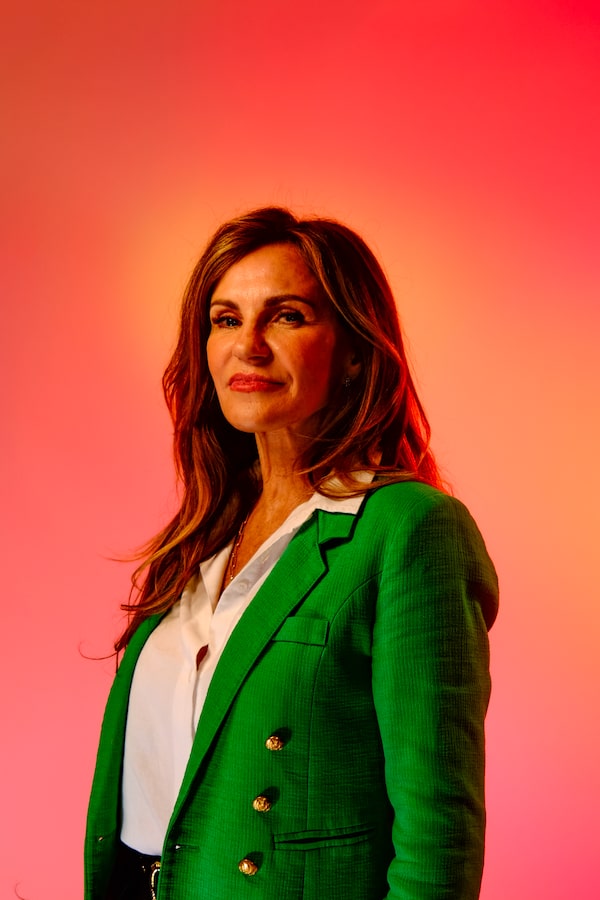
Lucie Andlauer of Subterra Renewables.Kate Dockeray/The Globe and Mail
Twenty years ago, Michael and Lucie Andlauer decided to put a geothermal energy system into the 70-acre property they then owned in Burlington, Ont. Geothermal was hardly new—public baths have been heated by energy from the Earth’s core for centuries, and countries like Iceland get two-thirds of their energy from this renewable resource. But Canada was slow to embrace it, preferring hydro, nuclear and traditional fossil fuels, all of which were then cheaper. But the Andlauers, Lucie says, “were looking at the future” and wanted to do something different. And they loved it. After the installation, their energy savings were huge—about $100,000 over the years—and, though few people talked about such things then, their carbon footprint dropped dramatically. The only hitch? The company that installed the system went bankrupt after two years, leaving nobody to maintain it.
In 1991, Michael Andlauer had started Andlauer Transportation Services (ATS), a wildly successful trucking firm that would eventually evolve into the Andlauer Healthcare Group—helping him amass a fortune of more than $1 billion, a chunk of which he famously used to buy the Ottawa Senators this past June. Lucie joined the company as VP of sales and service, and stayed for about 22 years. But she remained passionate, she says, about climate and environmental issues, and was particularly bullish on geothermal’s potential in the building industry. The heating of buildings is responsible for about 13% of Canada’s emissions. Geothermal exchange heating and cooling, however, can reduce GHG emissions by up to 95%. Andlauer talks quickly, knowing, like all of us do, that the climate clock is ticking. “Whether you’re a person who believes it or doesn’t believe it, something’s going on with Mother Nature,” she says. “The world is changing. We have to be responsible.”
About a decade ago, she and Corey Hawtin, the CEO of real estate developer Core Development Group, began exploring different companies and technologies. Few people, it seemed, were ready—governments, builders, even the companies themselves. The biggest obstacle was capital cost—the initial upfront outlay was high relative to other energy sources, and it took too long to see a return on investment. The Andlauers could afford to put geothermal in their home. Other people, not so much. Even as the climate crisis grew more dire, Andlauer knew that the only way forward for geothermal was to get those costs down. “People aren’t going to pay to go green,” Andlauer says. “We can all say it, but it’s not going to happen. Our entire goal was to get more people doing it for the right reasons.”
Andlauer and Hawtin eventually came up with an energy-as-a-service business model not dissimilar from other utilities. They would partner with real estate developers on new residential builds, using their own equipment and capital to install the holes and pipes before the developer had even begun the excavation. They would own and maintain the geothermal exchange system, then simply charge the developer for the energy captured and used by residents. Those charges could be set and remain the same for between 30 and 50 years.
The model worked because Andlauer had deep pockets, sure, but also because geothermal is predictable and reliable. In Ontario, the Earth’s temperature stays constant in the top 200 metres of crust: 6°C to 11°C depending where in the province you are. Simply put, a geothermal exchange system drills into that crust, runs pipes into those boreholes, and then pumps heat-transfer fluid or refrigerant through them. In the winter, that fluid absorbs warmth from the earth, and in the summer, the pumps run in reverse, removing heat from a building and transferring it to the ground. That heat can also be tuned very well, and is both more comfortable and more efficient—geothermal produces three to 4.5 kilowatts of heat for every kilowatt of electricity used. Crucially, unlike solar or wind, geothermal is unaffected by weather conditions, and unlike fossil fuels, it’s not as directly affected by geopolitical or supply-chain events. It’s free-flowing. You don’t even have to dig that far to access the necessary temperatures.
In 2017, Andlauer formed Subterra Renewables to commercialize this model. But even then, there was considerable skepticism around geothermal. “In the early days, it was one of those things where you get one contractor who does a poor job, and it gets in the news,” says Tyler Hamilton, senior director of climate at MaRS, “and suddenly geothermal is bad.” Indeed, Andlauer recalled discussing the technology with developer legend Ed Sorbara, who told her he would never put in geothermal. “I’m not doing it,” he told her. “I had a friend in 1970 who got it, and it didn’t work.” This wasn’t quite as silly as it sounded. Despite some high-profile geothermal successes like Markham District Energy—a municipally owned thermal-energy utility that went online in 2000—and a strengthening of Ontario’s geothermal drilling regulations in 2012, there were still, as Andlauer puts it, “cowboys” in the industry. Guys who had previously drilled water wells and mistakenly thought their skills were automatically transferable. Guys who didn’t test holes properly, who didn’t drain them. Holes caved in, sites got shut down, people abandoned the technology.
Andlauer knew it didn’t have to be that way. Thanks to her track record and Bay Street credibility, she was able to easily obtain meetings with senior development execs. She then began the slow process of teaching them about how beneficial, and lucrative, the technology could really be if installed and maintained properly. “We did about two years of education,” she says. While Andlauer says a geothermal exchange system is still 1.8 times more expensive than conventional HVAC, over time Subterra’s can save 65% or more in operating costs like service and maintenance, replacement parts and fuel. Tom Rand, the cleantech venture capitalist and author of The Case for Climate Capitalism, put a geothermal system into Planet Traveler, an environmentally conscious hostel he co-developed in downtown Toronto in 2014. He sees Subterra’s particular innovation as almost purely financial and legal. “They’re taking on all the capital and construction risk of it,” he says. “It’s smart. Owners and developers are not technically savvy, and they’re happy to offload that expertise.”
Andlauer put a considerable amount of her money where her mouth was. Early on, she bought seven condo buildings (in Burlington, Oakville and Brampton) that had existing geothermal systems designed and installed by a variety of companies. “We made tweaks,” she says, “but they were all operating pretty well. We learned some really good practices that we took to the future.” By 2019, Subterra had broken ground on a new geothermal system in Scarborough, Ont., in a Core development called Birchcliff Urban Towns. Now, Andlauer says, the systems practically sell themselves: “I wouldn’t exaggerate to say that every sales call I go on with my team, whether it’s a CEO or a large contract, we don’t really get any nos now. It’s just a matter of how and when we can fit it in our schedule.”
When it first began boring holes, Subterra outsourced the drilling. But the technology wasn’t especially complex—“bog-standard,” as Rand puts it—and, as Andlauer had discovered in the transportation sector, there were a lot of mom-and-pop shops in drills and rigs. “No one had the foresight to consolidate,” she says, another reason the industry had yet to take off. She realized if they wanted to be in business for a long time, and also push geothermal into the mainstream, Subterra needed to own its own drills, so it started procuring them. The company now has a fleet of more than 60 drills and rigs, the largest in North America.
At 850 feet of depth, an average 100,000-square-foot building requires 50 to 60 holes, spaced 15 feet apart. It takes just a single day to drill one hole (a day-and-a-half if you hit bedrock). The condos with which they’re currently partnering go up to more than a million square feet, and range in height from four to 40 storeys.

Andlauer formed Subterra Renewables in 2017, and five years later the company is partnered with about 100 different developers, primarily major players in Ontario.The Globe and Mail
Subterra currently partners with about 100 different developers, primarily major players in Ontario, including Mattamy Homes, DeSantis Homes and Chestnut Hill Developments. They have $400 million under contract, or about 50 new buildings, from Toronto to Ottawa to Calgary. Their drilling rigs are booked solid for the next year. With Chestnut Hill alone, they have five buildings under contract, all of which are in various stages of construction. The developer plans to install geothermal in all future builds, as well. “We’re very conscious about what’s happening in the environment,” Chestnut Hill chief operating officer Ralph Del Duca says. “And I think it’s a good way to give back.” It also allows them, Del Duca adds, to extend the energy stability that is geothermal’s chief selling feature: “We can give our homeowners some assurance that energy prices are going to stay at a certain number as opposed to shooting up when electricity or gas prices go up.” In heating mode, geothermal exchange costs 30% to 70% less than conventional HVAC; in cooling mode, 20% to 50%.
Andlauer believes geothermal hit a tipping point about a year ago, likening it in timing and growth to the electric vehicle revolution. Even as systems like Subterra’s are being installed in highrises, homeowners are putting both geothermal and air-exchange heat pumps into their residences at an unprecedented clip, motivated by both rising natural gas prices and sizeable government rebates. The climate crisis has also become more terrifying by the day: record heat waves around the globe, relentless forest fires, Arctic sea ice disappearing more quickly than previously projected.
At the same time, the response to the crisis has accelerated, if belatedly: Net-zero targets are the norm, renewables are cheaper than ever, and the aforementioned government incentives for sustainable infrastructure are more plentiful than ever before. The adoption of geothermal is one, possibly big, piece of that decarbonization puzzle. “People realize that if we’re ever going to get off fossil fuels,” says MaRS’s Hamilton, “we have to electrify heating. And the best way to do that? Geothermal or air-source heat pumps are the way to go.”
Earlier this year, Subterra raised $400 million in private equity, placing that money in a special fund for project expansion. The company recently met with the mayor of St. Catharines, Ont., to discuss energy use in the city’s municipal buildings. It currently has 23 employees and is adding more each year. The only check on further expansion, Andlauer says, is purchasing and integrating more drilling companies. “We can’t buy them fast enough,” she says. Andlauer predicts a shortage of those rigs soon, but Subterra is also now working with water-well and oil companies, reconfiguring their equipment for its own purposes.
In the face of climate cataclysm, though, would all this growth be enough? Andlauer is hopeful. “We have a new generation of builders coming in,” she says. “They think differently. And home buyers, finally, are demanding green buildings. I think you’re going to see a lot more people get into geothermal—which is great.”
CANADA’S TOP-GROWING COMPANIES 2023:
Canada’s Top Growing Companies 2023: Meet 425 businesses that will give you expansion envy
Canada’s Top Growing Companies: You can grow your own way
Upwardly mobile: Six of Canada’s Top Growing Companies on how they keep on expanding
Your time is valuable. Have the Top Business Headlines newsletter conveniently delivered to your inbox in the morning or evening. Sign up today.